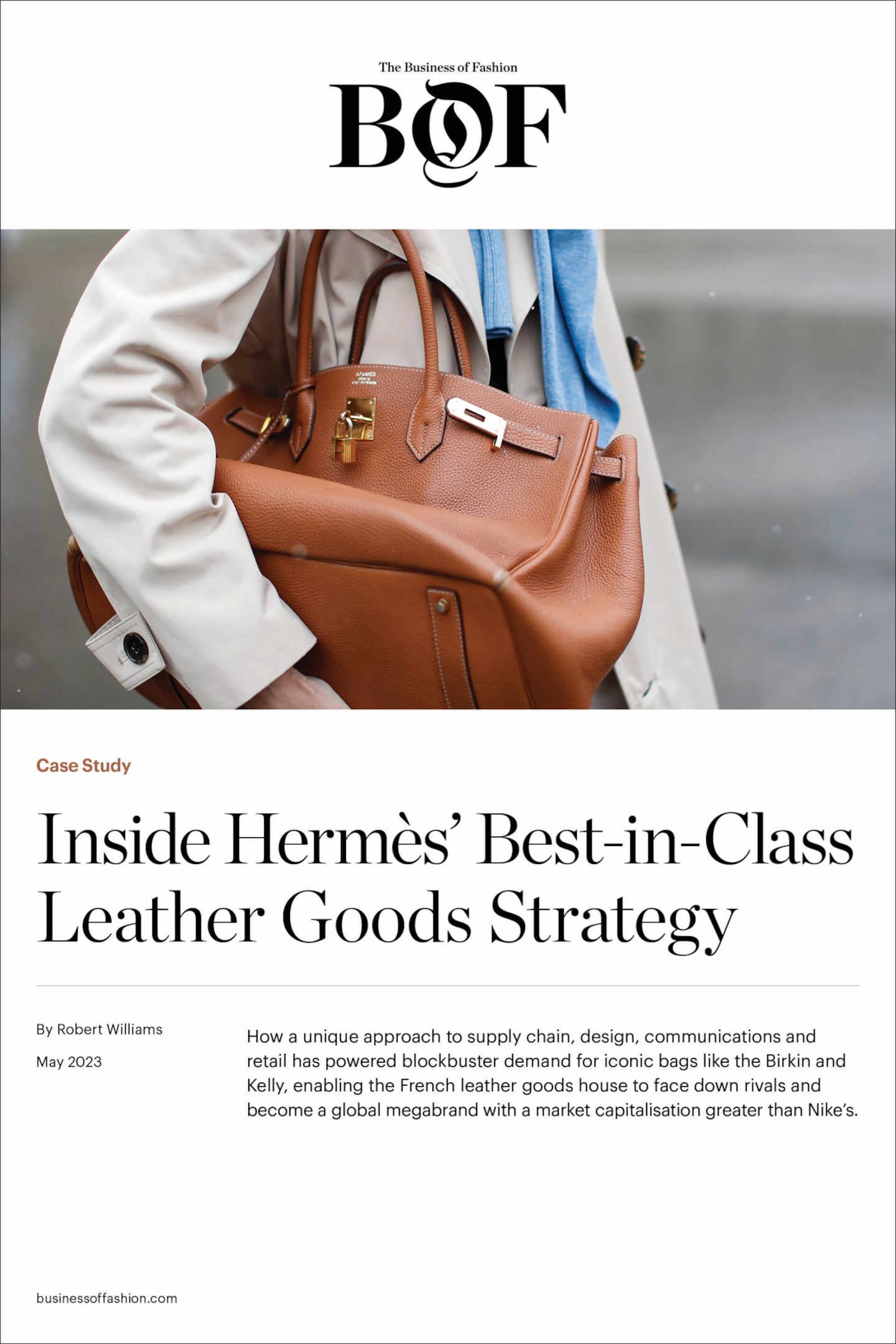
The Business of Fashion
Agenda-setting intelligence, analysis and advice for the global fashion community.

Agenda-setting intelligence, analysis and advice for the global fashion community.

In February 1993, Hermès floated its shares on the Paris Bourse at less than €6 each. By April 2023, its stock price had soared to more than €2,000 per share, lifting the company’s market capitalisation to €210 billion ($226 billion), surpassing Nike, the world’s biggest fashion brand by revenue with annual sales almost four times higher than Hermès. It was the latest endorsement by markets of the French label’s best-in-class leather goods strategy, which investors believe will continue to deliver steady growth and high profitability for years to come.
In this case study, The Business of Fashion dives deep into the unique product assortment, supply chain, communications and retail strategies that have powered Hermès’ rise as a global leader in the core handbag category. Even as the company seized rising demand for French luxury goods worldwide to grow annual sales exponentially — from around €588 million at the time of its public listing to €11.6 billion in 2022 — Hermès has retained, and even enhanced, an exclusive positioning anchored in the quality and scarcity of its flagship leather goods, including its famous Birkin and Kelly models.
While Hermès has surfed the same waves of luxury growth as competitors like Louis Vuitton, Chanel, Gucci and Dior, the company sets itself apart with a highly differentiated leather goods strategy. The brand retains its focus on top-price leather accessories, limiting cheaper-to-produce canvas lines that are a key profit driver for rivals, and prioritises top-quality, traditional manufacturing techniques over short-term growth. Unlike competitors, the company shuns assembly-line production and continues to train its leatherworkers to stitch bags by hand. “The real quality control of Hermès is the pride of the person who makes the bag,” chief executive Axel Dumas has said.
The approach has created scarcity that frustrates many would-be consumers of the brand’s bags. But this singular insistence on centuries-old standards has proven highly successful: Even as the company has expanded production at a stable pace for styles like the Birkin and Kelly (now accounting for over €2 billion in annual revenue, according to Bernstein estimates) their scarcity relative to demand has made shoppers only want them more.
ADVERTISEMENT
The quality and scarcity of Hermès’ flagship bags are just part of its unique approach. While rival brands have courted visibility through image-making couture, logo-driven merchandising, celebrity marketing and digital influencers, Hermès has preserved a more discreet image. Hermès historically kept quiet about its prestigious leather goods, instead focusing its advertisements on more accessible categories like silk scarves and perfume. Though its communication strategy has shifted somewhat, the company still largely relies on devoted customers to spread its leather-goods lore by word-of-mouth.
In a traditionally top-down luxury industry whose retail operations usually pivot around consistency and centralised control, Hermès has opted for a decentralised approach that gives store managers and sales associates an unusual degree of power over how and to whom its prestigious leather goods are sold, putting personal relationships with clients at the heart of the business.
The results have been staggering: Hermès is the world’s third-biggest luxury fashion brand by revenue (after Louis Vuitton and Chanel) as well as luxury’s most-profitable listed entity with an operating margin above 40 percent. A track record of weathering industry-wide crises better than rivals, like 2008′s global financial crisis or the Covid-19 pandemic, and quickly bouncing back, has made the company’s stock among the world’s most desirable investments, trading at over 60 times estimated earnings per share.
The company’s performance has allowed it to maintain the confidence of its controlling shareholders — the descendants of Thierry Hermès, now in their sixth generation of ownership — and fend off a takeover attempt by LVMH. Meanwhile, collectors on the secondary market continue to pay as much as three times retail prices for popular Hermès bags, a testament to their perceived exclusivity and desirability.
Looking ahead, Hermès faces challenges including managing unprecedented scale and a burgeoning resale market — both of which put pressure on the brand’s reputation for scarcity — as well as a digital media landscape populated by users attempting to demystify the “Hermès game,” a viral moniker for clients’ relationships with the sales associates who determine who gets to buy the brand’s bags. To protect its independence, the company will need to keep up its strong performance to convince shareholders the business hasn’t passed its prime. Further diversifying its leather goods business beyond Kelly and Birkin is a key opportunity, as is its still-nascent beauty business, which offers the company a means to reach customers at lower price points.
This case study breaks down Hermès’ leather goods success, showing how the company protects and grows its hero category while creating stability, profitability and self-determination in a fast-moving, competitive luxury fashion market — offering lessons for brands at every scale.
Click below to read the case study now.

The leather-goods powerhouse is testing alternative materials in a break with tradition, reimagining its ‘Victoria’ travel bag in a lab-grown substitute.
Hermès’ timeless positioning has helped sales bounce back ‘as if the pandemic never happened.’ But that doesn’t mean change isn’t afoot at the iconic French luxury house.
Kering’s first-quarter sales were a stress test for luxury demand after strong momentum at LVMH and Hermès pushed shares in the sector to dizzying heights.
How does a company that proudly eschews the usual means of generating desirability remain the most desirable luxury brand in the world?

Robert Williams is Luxury Editor at the Business of Fashion. He is based in Paris and drives BoF’s coverage of the dynamic luxury fashion sector.
The Swiss watch sector’s slide appears to be more pronounced than the wider luxury slowdown, but industry insiders and analysts urge perspective.
The LVMH-linked firm is betting its $545 million stake in the Italian shoemaker will yield the double-digit returns private equity typically seeks.
The Coach owner’s results will provide another opportunity to stick up for its acquisition of rival Capri. And the Met Gala will do its best to ignore the TikTok ban and labour strife at Conde Nast.
The former CFDA president sat down with BoF founder and editor-in-chief Imran Amed to discuss his remarkable life and career and how big business has changed the fashion industry.